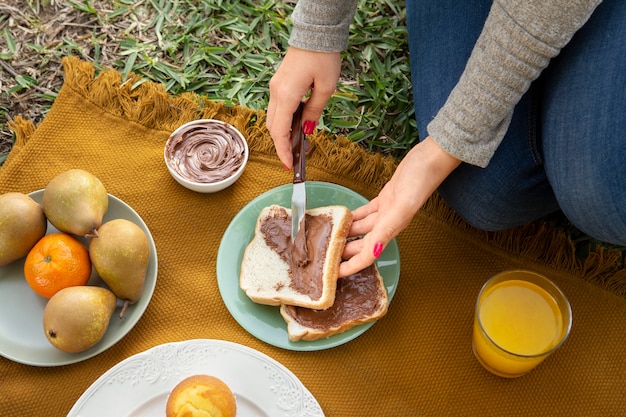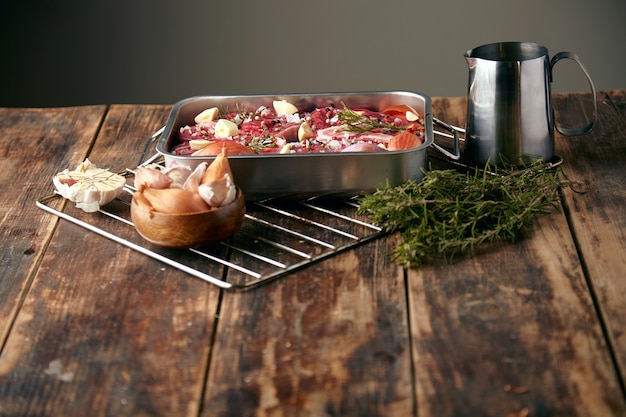You've got yourself a country ham, a beautiful, salty slab of cured pork, full of flavour and history. But now what? You're probably thinking, "How on earth do I cook this thing?" Well, don't worry, you've come to the right place. I've been cooking country hams for years, and I'm here to share all my tips and tricks, from understanding the basics of salt curing to whipping up some delicious dishes that'll have everyone asking for more. Let's dive into the fascinating world of country ham, shall we?
Part 1: Understanding the Country Ham

The History and Magic of Country Ham
First things first, let's talk about what makes country ham so special. It's not just any old ham, you see. It's a traditional method of preserving pork that dates back centuries. Imagine a time before refrigerators, when people needed to find ways to make their food last. Enter the country ham, a testament to our ancestors' ingenuity and resourcefulness. It's all about dry-curing the meat with salt, and a bit of sugar and other spices for good measure. This process draws out moisture, making the ham incredibly salty and long-lasting. Think of it as a delicious time capsule of flavour.
The origins of country ham can be traced back to the early days of American settlement, when people relied on traditional methods of food preservation to survive. Country ham became a staple in the Southern United States, where it was often cured in the cooler months and enjoyed throughout the year. Over time, it evolved into a culinary tradition, passed down through generations and cherished for its unique flavour and cultural significance.
What Makes a Country Ham Unique?
Now, you might be wondering, "What makes this country ham so different from the ham I buy at the supermarket?" Well, it's all about the curing process, mate. Country hams are dry-cured, meaning they are rubbed with a salt mixture and hung to dry for weeks, sometimes even months. This process gives them a distinctive, salty, and intensely flavourful character. It's a real taste of tradition.
Supermarket hams, on the other hand, are often wet-cured with a brine solution and then smoked. This process is much quicker, but it lacks the depth of flavour that comes from dry curing. Think of it this way: dry-curing is like slow-cooking for flavour. The salt draws out moisture, concentrating the natural flavours of the pork and creating a complex, salty, and umami-rich taste that's simply unmatched.
Part 2: The Art of Salt Curing

The Basics of Salt Curing
The salt curing process is the foundation of making a country ham. It's a bit like alchemy, turning plain pork into something extraordinary. The salt does more than just preserve the meat; it also draws out moisture and creates a concentrated flavour profile that's simply unmatched. It's all about patience, though. Dry curing takes time, sometimes weeks or even months.
The salt used in curing isn't just any ordinary table salt, though. It's typically a coarse salt, like kosher salt, which helps to draw out moisture and create a nice, even cure. The salt also acts as a natural preservative, inhibiting the growth of bacteria and extending the ham's shelf life. It's a beautiful example of how nature's ingredients can work together to create something truly delicious and enduring.
The Ingredients for Salt Curing
So, what goes into that magical salt cure? Well, the traditional mix usually includes:
- Salt: This is the primary ingredient, drawing moisture from the meat and preventing spoilage. It's usually the bulk of the cure.
- Sugar: Sugar helps balance the saltiness and adds a touch of sweetness. It also contributes to the ham's colour.
- Spices: Spices like black pepper, red pepper, and garlic are often added to enhance the flavour profile of the ham. Some recipes even call for a bit of paprika, which gives the ham a beautiful reddish hue.
- Saltpeter (Potassium Nitrate): This ingredient is used to cure the meat and give it a pink colour. It's crucial for the ham's safety and appearance. It also helps to prevent the growth of botulism, a dangerous bacteria that can form in cured meats.
The exact proportions of these ingredients can vary depending on the recipe and desired level of saltiness. But the fundamental principle remains the same: a carefully balanced mix of salt, sugar, spices, and saltpeter to create a flavorful and safe cure.
The Curing Process: A Step-by-Step Guide
You might be thinking, "Can I do this at home?" Well, you absolutely can! Here's a step-by-step guide to curing your own ham:
- Prepare the Meat: Start by trimming excess fat from the ham and ensuring it's free of any imperfections. This ensures that the cure penetrates evenly and helps to prevent spoilage.
- Prepare the Cure: Mix together your salt, sugar, spices, and saltpeter according to your chosen recipe. It's important to follow the recipe accurately, as the salt levels are crucial for proper curing.
- Rub the Cure: Rub the cure mixture liberally all over the ham, making sure to get into all the crevices. Use your hands to firmly press the cure into the meat, ensuring even coverage.
- Hang to Dry: Hang the ham in a cool, dry, well-ventilated area. Allow the ham to cure for several weeks, or even months, depending on the recipe and desired level of saltiness.
Curing a ham is a time-consuming process, but the results are truly worth it. As the ham hangs and dries, the salt draws out moisture and concentrates the flavours, creating that incredible salty and savory taste that we all love. During the curing process, a white crust will form on the surface of the ham. This is known as "salt bloom," and it's a sign that the curing process is working properly.
Tips for Curing a Country Ham:
Remember, patience is key when it comes to curing a ham. Here are a few tips to help you along the way:
- Use High-Quality Ingredients: The quality of your ham and cure ingredients will directly impact the final product, so choose wisely. A high-quality ham, preferably from a reputable source, will have a better flavour and texture.
- Maintain a Clean Environment: Ensure your curing area is clean and free from insects or pests. This will prevent contamination and spoilage. A clean and dry environment is essential for proper curing.
- Monitor Moisture Levels: During the curing process, check the ham regularly for any signs of moisture build-up. This could indicate improper curing. Excess moisture can lead to spoilage, so it's important to ensure good airflow around the ham.
- Keep a Journal: Keep track of the dates, temperatures, and any changes you observe during the curing process. This will help you understand the process and troubleshoot any problems. Having a record of your curing process can be helpful in case you encounter any issues. It can also help you refine your technique over time.
Part 3: Cooking the Country Ham

Preparing the Ham for Cooking
Okay, so your country ham is cured to perfection. Now it's time to cook it up! But first, there are a few things you'll want to do to prep it:
- Soak and Rinse: Country hams are incredibly salty, so you'll need to soak them in water before cooking to reduce the saltiness. Soak the ham in cold water for several hours, changing the water every few hours. The longer you soak the ham, the more salt you'll remove. You can even add a bit of apple cider vinegar to the water, which will help to tenderise the meat. The acidity of the vinegar helps to break down the tough proteins in the ham, making it more tender and flavorful.
- Trim the Fat: Trim away any excess fat from the ham. While a little fat is good, too much can make the ham greasy. Trimming the excess fat will also help the ham cook more evenly.
The soaking process is an important step in preparing a country ham. It helps to rehydrate the meat, making it more tender and juicy. It also helps to remove some of the excess salt, making it more palatable. The soaking time can vary depending on the size of the ham and the desired level of saltiness. If you're unsure how long to soak the ham, err on the side of longer. You can always soak it for less time next time.
Cooking Methods for Country Ham
Now that your ham is prepped, it's time to choose your cooking method. Here are a few popular options:
- Boiling: Boiling is a classic way to cook a country ham. It's a simple method that helps to evenly cook the ham and reduce the saltiness. You can boil the ham in a large pot of water, adding seasonings like bay leaves and peppercorns for extra flavour. Boiling is a great option if you want a tender ham that's not too salty. It's also a good way to cook a whole ham, as it ensures even cooking throughout.
- Baking: Baking is another great option for cooking a country ham. Preheat your oven to 325 degrees Fahrenheit (160 degrees Celsius) and place the ham in a roasting pan. You can add water to the bottom of the pan to create steam, which will help to keep the ham moist. Baking is a good option if you want a crispy skin and a more flavorful ham. You can also add seasonings like brown sugar or maple syrup to the pan for a sweet and savory flavour.
- slow cooking: Slow cooking is a fantastic way to achieve tender, juicy ham. Place the ham in your slow cooker and add water, seasonings, and even some vegetables. Cook on low for several hours, until the ham is tender. Slow cooking is a great option if you want a super tender and flavorful ham. It's also a good way to cook a ham that's been frozen, as the slow cooking process will help to thaw and cook the ham evenly.
Ultimately, the best cooking method for you will depend on your personal preferences and the type of ham you have. Experiment with different methods until you find one that you love.
cooking times and Temperatures
Here's a general guide for cooking times and temperatures, but remember to check the ham's internal temperature for doneness:
| Cooking Method | Temperature (°F) | Time (Hours) |
|---|---|---|
| Boiling | 200-212 | 3-4 |
| Baking | 325 | 2-3 |
| Slow Cooking | Low | 6-8 |
Remember, these are just estimates. The cooking time will depend on the size of the ham and the desired level of doneness. You can use a meat thermometer to check the internal temperature of the ham. The ham is cooked when it reaches an internal temperature of 145 degrees Fahrenheit (63 degrees Celsius).
Part 4: Serving and Enjoying
Slicing and Serving
Your country ham is cooked to perfection, and it's time to slice and serve it up! Here's what I do:
- Let it Cool: Let the ham cool slightly before slicing it. This will help prevent it from shredding. Allow the ham to rest for at least 30 minutes before slicing.
- Slice Thinly: Use a sharp knife to slice the ham thinly. This will make it easier to eat and enhance the flavour. A sharp knife will make slicing the ham easier and ensure that the slices are thin and even.
- Serve with Sides: Country ham is delicious on its own, but it also pairs beautifully with a variety of sides. Try serving it with mashed potatoes, collard greens, sweet potato casserole, and cornbread. These classic Southern sides complement the salty and savory flavour of the ham perfectly.
Country ham is also great for sandwiches, salads, and even breakfast dishes. It can be added to omelettes, frittatas, or used as a topping for pancakes or waffles. The possibilities are endless!
Preserving Leftovers
If you have leftovers, there are a few ways to store and enjoy them:
- Refrigerate: Store leftover ham in an airtight container in the refrigerator for up to 4 days.
- Freeze: You can freeze leftover ham for up to 3 months. Wrap it tightly in plastic wrap and then aluminum foil before freezing. Freezing is a great way to preserve leftover ham so you can enjoy it later.
When you're ready to use the frozen ham, thaw it in the refrigerator overnight. You can then reheat it in the oven, microwave, or slow cooker. Frozen country ham is a great ingredient for soups, stews, and casseroles. It can also be added to sandwiches and salads.
Part 5: Delicious Country Ham Dishes
Classic Ham and Biscuits
This is a true Southern classic, simple yet oh-so satisfying. Just imagine: flaky biscuits, dripping with a rich, buttery sauce, and topped with tender, salty country ham. It's a taste of heaven! The combination of the buttery biscuits, creamy sauce, and salty ham is truly divine. It's a dish that's sure to please everyone at the table.
Ham and bean soup
A hearty and comforting soup that's perfect for a cold day. The smoky flavour of the ham, combined with the earthy notes of the beans, makes for a truly delightful and satisfying meal. Ham and bean soup is a classic comfort food that's perfect for a chilly evening. It's also a great way to use up leftover ham.
ham and cheese quiche
For a more elegant touch, try a ham and cheese quiche. The flaky crust, creamy egg filling, and salty ham create a symphony of flavours. Serve it for brunch or a light lunch. Ham and cheese quiche is a versatile dish that can be served for breakfast, lunch, or dinner. It's also a great option for a crowd.
Ham Salad Sandwiches
Looking for a quick and easy lunch? Ham salad sandwiches are the perfect solution. Combine diced ham, mayonnaise, celery, and a sprinkle of mustard for a flavourful and satisfying sandwich. Ham salad sandwiches are a classic lunch staple that's easy to make and always a crowd-pleaser. They're also a great way to use up leftover ham.
Part 6: FAQs
What is the difference between a country ham and a regular ham?
Country hams are dry-cured, meaning they are rubbed with a salt mixture and hung to dry for weeks, sometimes even months. This process gives them a distinctive, salty, and intensely flavourful character. Regular hams are often wet-cured with a brine solution and then smoked, resulting in a milder flavour. Country hams are also typically made from the whole hog, while regular hams are usually made from just the hind leg.
How can I tell if a country ham is good?
A good country ham will have a firm texture, a deep red colour, and a salty, slightly sweet aroma. It should also be free of any signs of mold or spoilage. If the ham is soft or mushy, or has a foul odour, it's likely spoiled and should be discarded.
How long can I store a country ham?
A properly cured country ham can last for many months, even years, if stored correctly. Store it in a cool, dry, well-ventilated area. For longer storage, you can freeze the ham. A properly cured country ham is a testament to the power of natural preservation. It can last for a long time, making it a great option for long-term storage.
How do I reduce the saltiness of a country ham?
Soaking the ham in cold water for several hours before cooking is the best way to reduce the saltiness. You can also add a bit of apple cider vinegar to the water, which will help to tenderise the meat. The longer you soak the ham, the more salt you'll remove. You can also use a brine solution to reduce the saltiness of the ham. Brine solutions typically consist of water, salt, and sugar. You can also add other flavorings to the brine, such as herbs, spices, or citrus fruits.
What are some good side dishes to serve with country ham?
Country ham pairs well with a variety of sides, including mashed potatoes, collard greens, sweet potato casserole, cornbread, black-eyed peas, and green beans. These classic Southern sides complement the salty and savory flavour of the ham perfectly. You can also serve country ham with more modern sides, such as roasted vegetables, salads, or fruit salsas. The possibilities are endless!
Country ham is a culinary treasure, a taste of tradition and history. It's a versatile ingredient that can be used in a variety of dishes, from simple sandwiches to elegant meals. Whether you're a seasoned country ham connoisseur or a newcomer to this culinary delight, I hope this guide has inspired you to explore the world of country ham and discover its unique flavours for yourself.
Everyone is watching

Perfect Rice Every Time: The Ultimate Guide to Cooking Rice
Cooking TipsAs a self-proclaimed foodie, I've always been a bit obsessed with rice. It's the foundation of countless cuisi...

Prime Rib Roast Cooking Time Chart: Per Pound Guide
Cooking TipsPrime rib roast. Just the name conjures images of lavish dinners, crackling fires, and hearty laughter. It’s ...

The Ultimate Guide to Cooking Asparagus: Tips, Techniques, and Recipes
Cooking TipsAsparagus. The mere mention of this spring delicacy conjures up images of vibrant green spears, crisp and burs...

Ultimate Guide to Cooking the Perfect Thanksgiving Turkey
Cooking TipsThanksgiving. Just the word conjures up images of overflowing tables laden with delicious food, the scent of r...

How Long to Bake Potatoes in the Oven (Perfect Every Time)
Cooking TipsBaked potatoes are a staple in my kitchen. They're incredibly versatile, delicious, and surprisingly easy to m...
